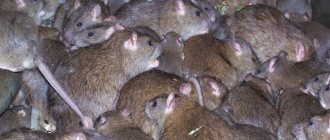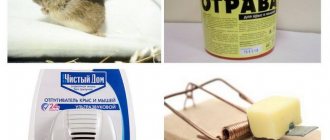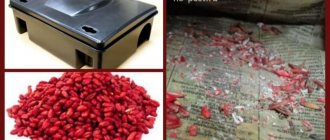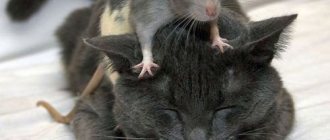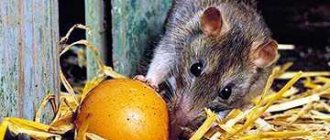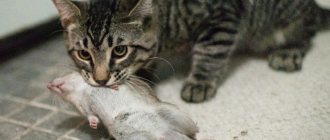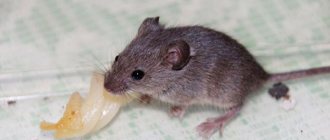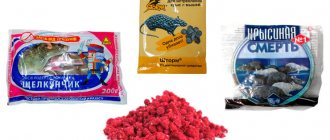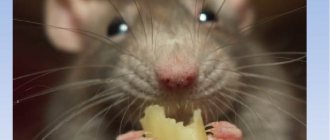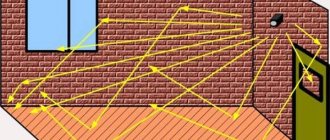Author: Michael Potter Updated: April 17, 2020
There are two types of rat baits: food (non-toxic) - for luring rats into a trap, and poisonous - for killing rodents. Food baits can be used for all types of rat traps, and poisons are most often used in conjunction with special stations for safety reasons. In this review we will talk about the 8 best poisons for rats and mice.
After ingesting poison, rodents die within a few hours to several weeks. Mice are smaller than rats and can die within a day, but rats die more slowly (a week or two). Poison baits are toxic and can kill any animal, including pets (cats and dogs), squirrels, raccoons and other wild animals. Be careful when using them around your pets and small children. Otherwise, instead of using poisons, you are better off purchasing an ultrasonic pest repeller to safely eliminate the animals that are bothering you.
Plastic container for mice
In order for poisoned baits to have maximum effect, special plastic bait containers should be used. They are used by pest control agents.
Their advantages:
- the poisonous bait is protected from atmospheric influences (wind, rain);
- equipped with a drinking bowl and a special place for poison;
- To attract the attention of rodents, the entrance resembles a hole.
Poison reserves can be easily and conveniently replenished; this is exactly what the design is designed for.
Alternative Methods
Often people prefer not to use toxic substances for safety reasons. After all, they are equally dangerous for chickens, dogs, cats and people. There are a number of ways that allow you to get rid of rats without causing danger. You can read about them using the links.
How to get rid of rats in a barn
Rats in the barn scare the animals and steal eggs. You need to get rid of them quickly, but at the same time take care of the safety of other residents.
How to get rid of rats on your property
Rats on the site spoil crops, bulbs, roots and gnaw the bark or shoots of young trees. They must be removed quickly, without delay.
Bromadiolone
Poison of the anticoagulant group. Once in the stomach of a rodent, it disrupts the synthesis of proteins of the prothrombin complex. Supplied as a liquid concentrate (0.25%) in 1.1 liter containers. In addition to the food base, attractants are recommended: unrefined sunflower oil, sugar. Any operations (cooking, laying out) are performed in special clothing and gloves.
Mass pest control products are toxic and 100% effective only when used correctly, so only certified specialists can use them. In this case, they are safe and the goal will be achieved.
Poison Ingredients: How Do Rodenticides Really Work?
Rodenticides are toxic to rodents, but, unfortunately, to humans too. All these baits bring death. Therefore, rat poisons are best used in conjunction with stations (like the Protecta LP Rat Bait Station for ~$18.49).
The active ingredients in rodenticides, which are classified as anticoagulants (such as warfarin, diphasinone, and bromadiolone), interfere with blood clotting, causing severe internal bleeding and ultimately death.
Products containing active substances other than anticoagulants are toxic in various ways. They can affect the nervous system (for example, bromethalin). They increase calcium levels in the blood, leading to kidney, liver or heart failure (eg cholecalciferol).
All poisons also belong to two different generations.
First generation poisons kill rodents slowly because they have a cumulative effect. For rodents to die, they need to eat the poison for several days, rather than just taste it once. Most rat and mouse baits these days fall into this group.
Second generation poisons (for example, containing bromadiolone, brodifacoum) can kill pests after just a single dose of the poison.
Poisons come in both block, granule and bar form (individually wrapped to help maintain the freshness and smell of the bait), etc.
- Using poison bait is usually less expensive than trapping because it is less labor intensive and rats do not have to be checked every day. Thus, in large rooms it is more profitable to use poisons.
- You should be aware that mice and rats can learn to identify baits and avoid them. To prevent this, scientists advise first laying out food bait to lull the vigilance of rodents, and then replacing it with a poisoned one.
- Liquid rat poison works great in dry areas.
Poisons and animals (cats, dogs)
Please note: There are no rat poisons that are safe for your pets! All poisonous baits are created to kill animals and can also harm cats and dogs. Be very careful: if the poison is swallowed, severe poisoning can occur. If you are concerned about pets, try an alternative method: electronic repellers. To get rid of rats, use only powerful repellers with a large area coverage.
User Cesar Rueda of the site warns: “Please be very careful when using bait if you have a dog. She won't be able to get into the bait station, but many rodents have a tendency to pull out and hide bits of poison all over the backyard..."
To prevent your cats or dogs from accidentally eating poison in the yard, you can, for example, attach poison to a strong wire on the fence or hide pieces of the toxic product in places where your pets do not go - and then wait for the dead rats.
“Just use the poison in garages and attics – ie. in areas where your children and pets would not normally go. It is possible that dying rats or mice will go outside and be eaten by other animals (though if you live in an urban area the likelihood is low compared to rural areas), but usually most die near the area where you used the product. After the death of a rodent, an unpleasant odor will certainly appear, which is why the poison must be used with caution in places where it will then be difficult to find the corpse and remove it.”
Yes, poisons kill rodents. But you don't know where exactly they will die. Dying rodents are looking for a quiet place, and you will be lucky if they manage to get outside. But it is possible that their death will happen right in your house or barn, then an unpleasant surprise awaits you - the smell of dead rats.
Smoke bombs
Such products are effective and inexpensive. In addition, with the help of smoke bombs you can get rid of not only annoying rodents, but also fungus, mold, various insects that poison life and even ticks. However, such products should also never be used in city apartments.
The active component of these drugs is sulfur. To use a checker, you must first study the instructions for a specific product in detail. After this, you need to remove flowers, food, and animals from the premises being treated. Once ignited, the bomb begins to emit very acrid smoke. It penetrates into all the cracks and corners of the room. Thus, pests are practically smoked out of the house. During the burning of the checker, you need to carefully monitor that a pet does not enter the house or a child runs into it. After treatment, you can forget about many pests for quite a long time. But many note the difficulty of using this method, which is why smoke bombs are at the end of the list in the rating.
Source
An effective means of baiting rats over a large area
The main means of fighting over large areas are:
- bait houses. Food containing poison is placed in them. They place houses in places where there are large concentrations of rodents. When a rodent comes inside, the house closes;
- treatment of burrows with rodenticides (poisons in powder form). Particles of the product fall on the fur, and then when licked inside the animal;
- filling holes Rats can chew through most materials, even concrete. Therefore, it is better to cover the holes with metal sheets or a wall made of cement, shells and crushed glass;
- traps and traps. Most often they have a wooden base. It is difficult to catch a rodent with such devices; they can only be used in secluded places once, since rats leave their odors, warning their relatives of danger;
- carbonation. A poisonous gas based on hydrogen phosphide or carbon monoxide is sprayed into a closed room. This mixture does not harm food products and disappears quickly, leaving no odor.
Small size is deceptive as the rat can be fast and agile
Rules for preparing poison with your own hands
Folk remedies for rats are significantly inferior to industrial ones, so they are often used as additional ones. There are several ways to prepare poison at home:
- gypsum in milk. You need to mix them so that the consistency remains liquid. In the rat's intestines, the gypsum thickens and interferes with natural nutritional processes, which is why the rodent dies. You need to be prepared for the fact that animals are able to recognize this threat, so the remedy may be ineffective;
- quicklime with sugar. In the rat's stomach, the lime heats up and corrodes its walls. The method is not the most effective, but accessible. There is no confirmation of information about the effectiveness of this method, but minimal harm will definitely be caused to rats;
- cork shavings. It can be mixed with any porridge or animal food. May cause gastric obstruction;
- crushed glass. It needs to be added to the bait, preferably liquid. Glass will cause severe harm to the digestive and circulatory systems;
- chilibukha tincture. It is added to liquid bait. The tincture is poisonous due to the strychnine content, but rodents easily detect this remedy due to its strong odor, similar to garlic.
You can add rat poison to water or milk.
Precautionary measures
Rat poison is also dangerous for humans, however, due to the low concentration in all products produced, the possibility of death tends to zero. But intoxication is possible, which is manifested by the following symptoms:
- headache;
- pallor;
- severe weakness;
- nausea;
- loss of appetite;
- bleeding of mucous membranes and gums.
The finished bait should be used according to the manufacturer's recommendations.
At high doses of rodenticide the following are possible:
- abdominal pain;
- diarrhea;
- vomit;
- blood in the stool;
- the appearance of hematomas on the body;
- fainting.
To prevent such manifestations, it is necessary to observe the following precautions:
- work with poison in a respirator, thick rubber gloves, safety glasses and a change of clothes;
- use modern means, since outdated drugs are too toxic;
- place poisonous baits in areas restricted for pets and children;
- when the first signs of intoxication appear, immediately call an ambulance;
- Before using poison, consult a specialist on the choice of drug and the required dosage.
The remains of the bait must be thrown into a hole about 1 m deep, away from living quarters.
Note! Rodents can often drag parts of baits over long distances, leaving them there.
Rodent control is always a complex process, including not only the installation of traps, but also their regular checking and replenishment. At the same time, the safety of all inhabitants of the house is extremely important.
Popular rat control products
You can purchase poison at any specialized store. When choosing, you should be guided not only by price, but also by other characteristics.
"Ratsid"
This is a highly toxic product (it is not fatal to humans, but precautions must still be taken). The lethal dose for a rodent is 20–25 mg. After eating food with “Rat”, the rodent dies from suffocation within 12–72 hours. If the poison does not work, the rat will develop immunity. "Krysid" can be used in different ways:
- spray into holes;
- mix with bait (it should be placed 3-4 days after feeding with non-poisoned food);
- pour into water.
"Krysid" is toxic to rats and can also cause poisoning in pets
"Ratox" and "Commando"
They are made on the basis of zinc oxide. Such means are much more dangerous than “Ratsid”. When zinc phosphide enters the digestive system, it begins to react with hydrochloric acid, releasing highly toxic hydrogen phosphide, which kills the rodent.
Ratox cannot be used in residential areas
These products have a specific odor and can react even with air, so their use in residential areas is strictly prohibited.
Commando poison easily reacts with air
